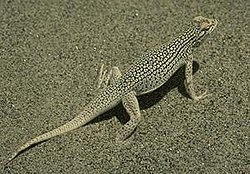| Fringe-toed lizard | |
|---|---|
 | |
| Coachella Valley fringe-toed lizard, Uma inornata | |
| Scientific classification | |
| Kingdom: | Animalia |
| Phylum: | Chordata |
| Class: | Reptilia |
| Order: | Squamata |
| Suborder: | Iguania |
| Family: | Phrynosomatidae |
| Genus: | Uma Baird, 1859 [1] |
Fringe-toed lizards are lizards of the genus Uma in the family Phrynosomatidae, native to deserts of North America. They are adapted for life in sandy deserts with fringe-like scales on their hind toes hence their common name.





